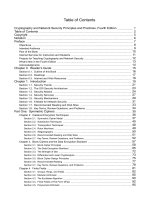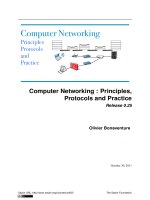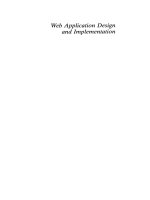web application architecture principles, protocols and practices
Bạn đang xem bản rút gọn của tài liệu. Xem và tải ngay bản đầy đủ của tài liệu tại đây (3.75 MB, 374 trang )
Web Application Architecture
Principles, protocols and practices
Leon Shklar
Richard Rosen
Dow Jones and Company
Web Application Architecture
Web Application Architecture
Principles, protocols and practices
Leon Shklar
Richard Rosen
Dow Jones and Company
Copyright 2003 by
John Wiley & Sons Ltd,
The Atrium, Southern Gate, Chichester,
West Sussex PO19 8SQ, England
Telephone (+44) 1243 779777
Email (for orders and customer service enquiries):
Visit our Home Page on www.wileyeurope.com or www.wiley.com
All Rights Reserved. No part of this publication may be reproduced, stored in a retrieval system or transmitted in
any form or by any means, electronic, mechanical, photocopying, recording, scanning or otherwise, except under the
terms of the Copyright, Designs and Patents Act 1988 or under the terms of a licence issued by the Copyright
Licensing Agency Ltd, 90 Tottenham Court Road, London W1T 4LP, UK, without the permission in writing of the
Publisher with the exception of any material supplied specifically for the purpose of being entered and executed on a
computer system for exclusive use by the purchase of the publication. Requests to the Publisher should be addressed
to the Permissions Department, John Wiley & Sons Ltd, The Atrium, Southern Gate, Chichester, West Sussex PO19
8SQ, England, or emailed to , or faxed to (+44) 1243 770620.
This publication is designed to provide accurate and authoritative information in regard to the subject matter
covered. It is sold on the understanding that the Publisher is not engaged in rendering professional services. If
professional advice or other expert assistance is required, the services of a competent professional should be sought.
Other Wiley Editorial Offices
John Wiley & Sons Inc., 111 River Street, Hoboken, NJ 07030, USA
Jossey-Bass, 989 Market Street, San Francisco, CA 94103-1741, USA
Wiley-VCH Verlag GmbH, Boschstr. 12, D-69469 Weinheim, Germany
John Wiley & Sons Australia Ltd, 33 Park Road, Milton, Queensland 4064, Australia
John Wiley & Sons (Asia) Pte Ltd, 2 Clementi Loop #02-01, Jin Xing Distripark, Singapore 129809
John Wiley & Sons Canada Ltd, 22 Worcester Road, Etobicoke, Ontario, Canada M9W 1L1
Wiley also publishes its books in a variety of electronic formats. Some content that appears
in print may not be available in electronic books.
Library of Congress Cataloging-in-Publication Data
Shklar, Leon.
Web application architecture : principles, protocols, and practices /
Leon Shklar, Richard Rosen.
p. cm.
Includes bibliographical references and index.
ISBN 0-471-48656-6 (Paper : alk. paper)
1. Web sites—Design. 2. Application software—Development. I.
Rosen, Richard. II. Title.
TK5105.888.S492 2003
005.7 2—dc21
2003011759
British Library Cataloguing in Publication Data
A catalogue record for this book is available from the British Library
ISBN 0-471-48656-6
Typeset in 10/12.5pt Times by Laserwords Private Limited, Chennai, India
Printed and bound in Great Britain by Antony Rowe Ltd, Chippenham, Wiltshire
This book is printed on acid-free paper responsibly manufactured from sustainable forestry
in which at least two trees are planted for each one used for paper production.
Contents
Acknowledgements
1.
Introduction
1.1
1.2
1.3
1.4
1.5
The Web in Perspective
The Origins of the Web
From Web Pages to Web Sites
From Web Sites to Web Applications
How to Build Web Applications in One Easy Lesson
1.5.1 Web page design resources
1.5.2 Web site design resources
1.5.3 Web application design resources
1.5.4 Principles of web application design
1.6 What is Covered in this Book
Bibliography
2.
Before the Web: TCP/IP
2.1 Historical Perspective
2.2 TCP/IP
2.2.1 Layers
2.2.2 The client/server paradigm
2.3 TCP/IP Application Services
2.3.1 Telnet
2.3.2 Electronic mail
2.3.3 Message forums
2.3.4 Live messaging
2.3.5 File servers
2.4 And Then Came the Web. . .
2.5 Questions and Exercises
Bibliography
xiii
1
1
2
3
4
5
5
5
6
7
8
9
11
11
13
13
14
16
16
16
24
25
25
27
27
28
vi
Contents
3.
Birth of the World Wide Web: HTTP
3.1
3.2
3.3
3.4
3.5
3.6
3.7
3.8
4.
Historical Perspective
Building Blocks of the Web
The Uniform Resource Locator
Fundamentals of HTTP
3.4.1 HTTP servers, browsers, and proxies
3.4.2 Request/response paradigm
3.4.3 Stateless protocol
3.4.4 The structure of HTTP messages
3.4.5 Request methods
3.4.6 Status codes
Better Information Through Headers
3.5.1 Type support through content-type
3.5.2 Caching control through Pragma and Cache-Control
headers
3.5.3 Security through WWW-Authenticate and
Authorization headers
3.5.4 Session support through Cookie and Set-Cookie
headers
Evolution
3.6.1 Virtual hosting
3.6.2 Caching support
3.6.3 Persistent connections
Summary
Questions and Exercises
Bibliography
Web Servers
4.1 Basic Operation
4.1.1 HTTP request processing
4.1.2 Delivery of static content
4.1.3 Delivery of dynamic content
4.2 Advanced Mechanisms for Dynamic Content Delivery
4.2.1 Beyond CGI and SSI
4.2.2 Native APIs (ISAPI and NSAPI)
4.2.3 FastCGI
4.2.4 Template processing
4.2.5 Servlets
4.2.6 Java server pages
4.2.7 Future directions
29
29
30
30
32
33
33
34
35
37
42
46
48
51
53
56
59
60
61
62
63
63
64
65
66
67
69
71
81
81
81
81
82
84
85
87
Contents
vii
4.3 Advanced Features
4.3.1 Virtual hosting
4.3.2 Chunked transfers
4.3.3 Caching support
4.3.4 Extensibility
4.4 Server Configuration
4.4.1 Directory structure
4.4.2 Execution
4.4.3 Address resolution
4.4.4 MIME support
4.4.5 Server extensions
4.5 Server Security
4.5.1 Securing the installation
4.5.2 Dangerous practices
4.5.3 Secure HTTP
4.5.4 Firewalls and proxies
4.6 Summary
4.7 Questions and Exercises
Bibliography
5.
Web Browsers
5.1 Architectural Considerations
5.2 Processing Flow
5.3 Processing HTTP Requests and Responses
5.3.1 HTTP requests
5.3.2 HTTP responses
5.4 Complex HTTP Interactions
5.4.1 Caching
5.4.2 Cookie coordination
5.4.3 Authorization: challenge and response
5.4.4 Re-factoring: common mechanisms for storing
persistent data
5.4.5 Requesting supporting data items
5.4.6 Multimedia support: helpers and plug-ins
5.5 Review of Browser Architecture
5.6 Summary
5.7 Questions and Exercises
Bibliography
88
88
89
90
91
91
92
92
93
94
95
96
96
97
98
98
100
100
102
103
105
107
112
113
120
125
125
128
129
131
133
134
136
139
139
140
viii
Contents
6.
HTML and its Roots
6.1 Standard Generalized Markup Language
6.1.1 The SGML declaration
6.1.2 Document type definition
6.2 HTML
6.2.1 HTML evolution
6.2.2 Structure and syntax
6.3 HTML Rendering
6.3.1 Cascading style sheets
6.3.2 Associating styles with HTML documents
6.4 JavaScript
6.5 DHTML
6.5.1 ‘Mouse-Over’ behaviors
6.5.2 Form validation
6.5.3 Layering techniques
6.6 Summary
6.7 Questions and Exercises
Bibliography
7.
XML Languages and Applications
7.1 Core XML
7.1.1 XML documents
7.1.2 XML DTD
7.1.3 XML schema
7.2 XHTML
7.3 WML
7.4 XSL
7.4.1 XSLT
7.4.2 XSL formatting objects
7.4.3 What is so important about XSL?
7.5 Summary
7.6 Questions and Exercises
Bibliography
8.
Dynamic Web Applications
8.1 Historical Perspective
8.1.1 Client-server applications
8.1.2 Web applications
8.1.3 Multi-tier web applications
141
141
143
146
150
151
152
157
158
159
161
164
164
165
167
168
169
169
171
172
172
175
177
182
183
186
186
189
195
197
198
199
201
201
201
202
203
Contents
ix
8.2 Application Architecture
8.2.1 Interpreting and routing client requests
8.2.2 Controlling user access to the application
8.2.3 Enabling data access
8.2.4 Accessing and modifying content
8.2.5 Customizing content for presentation
8.2.6 Transmitting the formatted response
8.2.7 Logging and recording application activity
8.3 Database Processing Issues
8.3.1 Configuration
8.3.2 Transactions
8.3.3 Best practices
8.4 Summary
8.5 Questions and Exercises
Bibliography
9.
Approaches to Web Application Development
9.1 Programmatic Approaches
9.1.1 CGI
9.1.2 Java Servlet API
9.2 Template Approaches
9.2.1 Server-Side Includes (SSI)
9.2.2 Cold Fusion
9.2.3 WebMacro/Velocity
9.3 Hybrid Approaches
9.3.1 PHP
9.3.2 Active Server Pages (ASP)
9.3.3 Java Server Pages
9.4 Separation of Content from Presentation
9.4.1 Application flexibility
9.4.2 Division of responsibility for processing
modules
9.5 Frameworks: MVC Approaches
9.5.1 JSP ‘Model 2’
9.5.2 Struts
9.6 Frameworks: XML-Based Approaches
9.7 Summary
9.8 Questions and Exercises
Bibliography
203
205
208
216
223
231
235
235
237
238
239
241
242
242
243
245
246
246
247
247
249
250
252
254
254
255
256
259
259
261
262
262
264
266
267
269
270
x
Contents
10.
Application Primer: Virtual Realty Listing Services
271
10.1
10.2
10.3
10.4
273
274
276
278
282
288
295
297
297
10.5
10.6
10.7
10.8
11.
Application Requirements
Application Development Environment
Anatomy of a Struts Application
The Structure of the VRLS Application
10.4.1 Controller: ActionServlet and custom actions
10.4.2 View: JSP Pages and ActionForms
10.4.3 Model: JavaBeans and auxiliary service classes
Design Decisions
10.5.1 Abstracting functionality into service classes
10.5.2 Using embedded page inclusion to support
co-branding
10.5.3 A single task for creation and modification of
customer profiles
Enhancements
10.6.1 Administrative interface
10.6.2 Enhancing the signup process through e-mail
authentication
10.6.3 Improving partner recognition through a persistent
cookie
10.6.4 Adding caching functionality to the DomainService
Class
10.6.5 Paging through cached search results using the value
list handler pattern
10.6.6 Using XML and XSLT for view presentation
10.6.7 Tracking user behavior
Summary
Questions and Exercises
Bibliography
298
300
301
301
304
305
306
307
308
310
311
311
312
Emerging Technologies
313
11.1 Web Services
11.1.1 SOAP
11.1.2 WSDL
11.1.3 UDDI
11.2 Resource Description Framework
11.2.1 RDF and Dublin Core
11.2.2 RDF Schema
11.3 Composite Capability/Preference Profiles
11.4 Semantic Web
11.5 XML Query Language
314
314
317
319
322
322
326
328
331
332
Contents
xi
11.6 The Future of Web Application Frameworks
11.6.1 One more time: separation of content from
presentation
11.6.2 The right tools for the job
11.6.3 Simplicity
11.7 Summary
11.8 Questions and Exercises
Bibliography
Index
335
335
337
338
343
344
344
347
Acknowledgements
I would like to thank my wife Rita and daughter Victoria for their insightful ideas
about this project. I also wish to thank my mother and the rest of my family for
their support and understanding.
Leon Shklar
Thanks to my wife, Celia, for tolerating and enduring all the insanity associated
with the writing process, and to my parents and the rest of my family for all they
have done, not only in helping me finish this book, but in enabling Celia and me
to have the most fantastic wedding ever in the midst of all this.
Rich Rosen
We would both like to acknowledge the following people for their guidance and
assistance:
• Karen Mosman and Jill Jeffries at John Wiley & Sons, Ltd for getting this book
off the ground,
• Our editor, Gaynor Redvers-Mutton, and her assistant, Jonathan Shipley, for lighting the fire underneath us that finally got us to finish it.
• Nigel Chapman and Bruce Campbell for taking the time to review our work and
provide us with valuable insights and advice.
• And finally, our friends and colleagues from the glory days of Pencom Web
Works—especially Howard Fishman, Brad Lohnes, Dave Makower, and Evan
Coyne Maloney—whose critiques, comments, and contributions were as thorough, methodical, and nitpicky (and we mean that in a good way!) as an author
could ever hope for.
1
Introduction
1.1 THE WEB IN PERSPECTIVE
A little more than a decade ago at CERN (the scientific research laboratory near
Geneva, Switzerland), Tim Berners-Lee presented a proposal for an information
management system that would enable the sharing of knowledge and resources over
a computer network.
The system he proposed has propagated itself into what can truly be called a
World Wide Web, as people all over the world use it for a wide variety of purposes:
• Educational institutions and research laboratories were among the very first users
of the Web, employing it for sharing documents and other resources across
the Internet.
• Individuals today use the Web (and the underlying Internet technologies that support it) as an instantaneous international postal service, as a worldwide community
bulletin board for posting virtual photo albums, and as a venue for holding global
yard sales.
• Businesses engage in e-commerce, offering individuals a medium for buying and
selling goods and services over the net. They also communicate with other businesses through B2B (business-to-business) data exchanges, where companies can
provide product catalogues, inventories, and sales records to other companies.
The Web vs. the Internet
There is an often-overlooked distinction between the Web and the Internet. The line
between the two is often blurred, partially because the Web is rooted in the fundamental
protocols associated with the Internet. Today, the lines are even more blurred, as
notions of ‘the Web’ go beyond the boundaries of pages delivered to Web browsers,
2
Introduction
into the realms of wireless devices, personal digital assistants, and the next generation
of Internet appliances.
1.2 THE ORIGINS OF THE WEB
Tim Berners-Lee originally promoted the World Wide Web as a virtual library, a document control system for sharing information resources among researchers. Online
documents could be accessed via a unique document address, a Universal Resource
Locator (URL). These documents could be cross-referenced via hypertext links.
Hypertext
Ted Nelson, father of the Xanadu Project, coined the term ‘hypertext’ over 30 years
ago, as a way of describing ‘non-sequential writing—text that branches and allows
choice to the reader.’ Unlike the static text of print media, it is intended for use with
an interactive computer screen. It is open, fluid and mutable, and can be connected to
other pieces of hypertext by ‘links’.
The term was extended under the name hypermedia to refer not only to text, but to
other media as well, including graphics, audio, and video. However, the original term
hypertext persists as the label for technology that connects documents and information
resources through links.
From the very beginnings of Internet technology, there has been a dream of
using the Internet as a universal medium for exchanging information over computer
networks. Many people shared this dream. Ted Nelson’s Xanadu project aspired
to make that dream a reality, but the goals were lofty and were never fully realized. Internet file sharing services (such as FTP and Gopher) and message forum
services (such as Netnews) provided increasingly powerful mechanisms for this
sort of information exchange, and certainly brought us closer to fulfilling those
goals.
However, it took Tim Berners-Lee to (in his own words) “marry together” the
notion of hypertext with the power of the Internet, bringing those initial dreams
to fruition in a way that the earliest developers of both hypertext and Internet
technology might never have imagined. His vision was to connect literally everything
together, in a uniform and universal way.
From Web Pages to Web Sites
3
Internet Protocols are the Foundation of Web Technology
It should be noted that the Web did not come into existence in a vacuum. The Web is
built on top of core Internet protocols that had been in existence for many years prior to
the Web’s inception. Understanding the relationship between ‘Web technology’ and the
underlying Internet protocols is fundamental to the design and implementation of true
‘Web applications’. In fact, it is the exploitation of that relationship that distinguishes
a ‘Web page’ or ‘Web site’ from a ‘Web application’.
1.3 FROM WEB PAGES TO WEB SITES
The explosively exponential growth of the Web can at least partially be attributed to
its grass roots proliferation as a tool for personal publishing. The fundamental technology behind the Web is relatively simple. A computer connected to the Internet,
running a Web server, was all that was necessary to serve documents. Both CERN
and the National Center for Supercomputer Applications (NCSA) at the University
of Illinois had developed freely available Web server software. A small amount of
HTML knowledge (and the proper computing resources) got you something that
could be called a Web site.
Primitive Web Sites from the Pre-Cambrian Era
Early Web sites were, in fact, just loosely connected sets of pages, branched off
hierarchically from a home page. HTML lets you link one page to another, and a
collection of pages linked together could be considered a ‘Web site’. But a Web site
in this day and age is more than just a conglomeration of Web pages.
Granted, when the Web was in its infancy, the only computers connected to the
Internet and capable of running server software were run by academic institutions
and well-connected technology companies. Smaller computers, in any case, were
hardly in abundance back then. In those days, a ‘personal’ computer sitting on your
desktop was still a rarity. If you wanted access to any sort of computing power, you
used a terminal that let you ‘log in’ to a large server or mainframe over a direct
connection or dialup phone line.
Still, among those associated with such organizations, it quickly became a very
simple process to create your own Web pages. Moreover, all that was needed was
a simple text editor. The original HTML language was simple enough that, even
4
Introduction
without the more sophisticated tools we have at our disposal today, it was an easy
task for someone to create a Web page. (Some would say too easy.)
“Welcome to My Home Page, Here Are Photos of My Cat and A Poem I Wrote”
In those pioneer days of the Web, academic and professional organizations used the
Web to share information, knowledge, and resources. But once you got beyond those
hallowed halls and cubicle walls, most people’s Web pages were personal showcases
for publishing bad poetry and pictures of their pets. The thought of a company offering information to the outside world through the Web, or developing an intranet to
provide information to its own employees, was no more than a gleam in even the most
prophetic eyes.
There is a big difference between a Web page and a Web site. A Web site is more
than just a group of Web pages that happen to be connected to each other through
hypertext links.
At the lowest level, there are content-related concerns. Maintaining thematic
consistency of content is important in giving a site some degree of identity.
There are also aesthetic concerns. In addition to having thematically-related content, a Web site should also have a common look and feel across all of its pages, so
that site visitors know they are looking at a particular Web site. This means utilizing a common style across the site: page layout, graphic design, and typographical
elements should reflect that style.
There are also architectural concerns. As a site grows in size and becomes
more complex, it becomes critically important to organize its content properly. This
includes not just the layout of content on individual pages, but also the interconnections between the pages themselves. Some of the symptoms of bad site design
include links targeting the wrong frame (for frame-based Web sites), and links that
take visitors to a particular page at an appropriate time (e.g. at a point during the
visit when it is impossible to deliver content to the visitors).
If your site becomes so complex that visitors cannot navigate their way through it,
even with the help of site maps and navigation bars, then it needs to be reorganized
and restructured.
1.4 FROM WEB SITES TO WEB APPLICATIONS
Initially, what people shared over the Internet consisted mostly of static information
found in files. They might edit these files and update their content, but there were
few truly dynamic information services on the Internet. Granted, there were a few
exceptions: search applications for finding files found on FTP archives and Gopher
How to Build Web Applications in One Easy Lesson
5
servers; and services that provided dynamic information directly, like the weather,
or the availability of cans from a soda dispensing machine. (One of the first Web
applications that Tim Berners-Lee demonstrated at CERN was a gateway for looking
up numbers from a phone book database using a Web browser.)
However, for the most part the information resources shared on the Web were
static documents. Dynamic information services—from search engines to CGI
scripts to packages that connected the Web to relational databases—changed all that.
With the advent of the dynamic web, the bar was raised even higher. No longer
was it sufficient to say that you were designing a ‘Web site’ (as opposed to a motley
collection of ‘Web pages’). It became necessary to design a Web application.
Definition of a Web Application
What is a ‘Web application?’ By definition, it is something more than just a ‘Web site.’
It is a client/server application that uses a Web browser as its client program, and performs an interactive service by connecting with servers over the Internet (or Intranet).
A Web site simply delivers content from static files. A Web application presents
dynamically tailored content based on request parameters, tracked user behaviors, and
security considerations.
1.5 HOW TO BUILD WEB APPLICATIONS IN ONE
EASY LESSON
But what does it mean to design a Web application, as contrasted to a Web page
or a Web site? Each level of Web design has its own techniques, and its own set
of issues.
1.5.1 Web page design resources
For Web page design, there is a variety of books available. Beyond the tutorial
books that purport to teach HTML, JavaScript, and CGI scripting overnight, there
are some good books discussing the deeper issues associated with designing Web
pages. One of the better choices is The Non-Designer’s Web Book by Robin Williams
(not the comedian). Williams’ books are full of useful information and guidelines
for those constructing Web pages, especially those not explicitly schooled in design
or typography.
1.5.2 Web site design resources
When it comes to Web sites, there are far fewer resources available. Information
Architecture for the World Wide Web, by Louis Rosenfeld and Peter Morville, was
6
Introduction
one of the rare books covering the issues of designing Web sites as opposed to Web
pages. It is unfortunately out of print.
1.5.3 Web application design resources
When we examined the current literature available on the subject of Web application development, we found there were three main categories of books currently available.
• Technical Overviews. The first category is the technical overview. These books
are usually at a very high level, describing terminology and technology in broad
terms. They do not go into enough detail to enable the reader to design and
build serious Web applications. They are most often intended for ‘managers’ and
‘executives’ who want a surface understanding of the terminology without going
too deeply into specific application development issues. Frequently, they attempt
to cover technology in huge brushstrokes, so that you see books whose focus is
simply ‘Java’, ‘XML’, or ‘The Web.’
Such books approach the spectrum of technology so broadly that the coverage
of any specific area is too shallow to be significant. Serious application developers
usually find these books far too superficial to be of any use to them.
• In-Depth Technical Resources. The second category is comprised of in-depth
technical resources for developing Web applications using specific platforms.
The books in this category provide in-depth coverage of very narrow areas,
concentrating on the ‘how-to’s’ of using a particular language or platform without explaining what is going on ‘under the hood.’ While such books may be
useful in teaching programmers to develop applications for a specific platform,
they provide little or no information about the underlying technologies, focusing
instead on the platform-specific implementation of those technologies. Should
developers be called upon to rewrite an application for another platform, the
knowledge they acquired from reading these books would rarely be transferable
to that new platform.
Given the way Web technology changes so rapidly, today’s platform of choice
is tomorrow’s outdated legacy system. When new development platforms emerge,
developers without a fundamental understanding of the inner workings of Web
applications have to learn their inner workings from the ground up, because
they lacked an understanding of first principles—of what the systems they wrote
really did. Thus, the ability to use fundamental technological knowledge across
platforms is critical.
• Reference Books. These form a third category. Such books are useful, naturally,
as references, but not for the purpose of learning about the technology.
What we found lacking was a book that provides an in-depth examination of
the basic concepts and general principles of Web application development. Such
How to Build Web Applications in One Easy Lesson
7
a book would cover the core protocols and technologies of the Internet in depth,
imparting the principles associated with writing applications for the Web. It would
use examples from specific technologies (e.g. CGI scripts and servlets), but would
not promote or endorse particular platforms.
Why is Such a Book Needed?
We see the need for such a book when interviewing job candidates for Web application
development positions. Too many programmers have detailed knowledge of a particular
API (Application Programming Interface), but they are lost when asked questions
about the underlying technologies (e.g. the format and content of messages transmitted
between the server and browser). Such knowledge is not purely academic—it is critical
when designing and debugging complex systems.
Too often, developers with proficiency only within a specific application development platform (like Active Server Pages, Cold Fusion, PHP, or Perl CGI scripting)
are not capable of transferring that proficiency directly to another platform. Only
through a fundamental understanding of the core technology can developers be
expected to grow with the rapid technological changes associated with Web application development.
1.5.4 Principles of web application design
What do we mean when we discuss the general principles that need to be understood
to properly design and develop Web applications?
We mean the core set of protocols and languages associated with Web applications. This includes, of course, HTTP (HyperText Transfer Protocol ) and HTML
(HyperText Markup Language), which are fundamental to the creation and transmission of Web pages. It also includes the older Internet protocols like Telnet and
FTP, protocols used for message transfer like SMTP and IMAP, plus advanced protocols and languages like XML. Additionally, it includes knowledge of databases
and multimedia presentation, since many sophisticated Web applications make use
of these technologies extensively.
The ideal Web application architect must in some sense be a ‘jack of all trades’.
People who design Web applications must understand not only HTTP and HTML,
but the other underlying Internet protocols as well. They must be familiar with
JavaScript, XML, relational databases, graphic design and multimedia. They must
be well versed in application server technology, and have a strong background in
information architecture. If you find people with all these qualifications, please let us
know—we would love to hire them! Rare is the person who can not only architect
a Web site, but also design the graphics, create the database schema, produce the
multimedia programs, and configure the e-commerce transactions.
8
Introduction
In the absence of such a Web application superhero/guru/demigod, the best you
can hope for is a person who at least understands the issues associated with designing
Web applications. Someone who understands the underlying languages and protocols
supporting such applications. Someone who can understand the mechanisms for
providing access to database and multimedia information through a Web application.
We hope that, by reading this book, you can acquire the skills needed to design
and build complex applications for the World Wide Web. No, there is no ‘one easy
lesson’ for learning the ins and outs of designing Web applications. However, this
book will hopefully enable you to design and build sophisticated Web applications
that are scaleable, maintainable, extensible, and reusable.
We examine various approaches to the process of Web application development—starting with the CGI approach, looking at template languages like Cold
Fusion and ASP, and working our way up to the Java Enterprise (J2EE ) approach.
However, at each level, we concentrate not on the particular development platform,
but on the considerations associated with designing and building Web applications
regardless of the underlying platform.
1.6 WHAT IS COVERED IN THIS BOOK
The organization of this book is as follows:
• Chapter 2: TCP/IP— This chapter examines the underlying Internet protocols
that form the basis of the Web. It offers some perspectives on the history of
TCP/IP, as well as some details about using several of these protocols in Web
applications.
• Chapter 3: HTTP— The HTTP protocol is covered in detail, with explanations
of how requests and responses are transmitted and processed.
• Chapter 4: Web Servers— The operational intricacies of Web servers is the
topic here, with an in-depth discussion of what Web servers must do to support
interactions with clients such as Web browsers and HTTP proxies.
• Chapter 5: Web Browsers— As the previous chapter dug deep into the inner
workings of Web servers, this chapter provides similar coverage of the inner
workings of Web browsers.
• Chapter 6: HTML and Its Roots— In the first of our two chapters about
markup languages, we go back to SGML to learn more about the roots of HTML
(and XML as well).
• Chapter 7: XML— This chapter covers XML and related specifications, including XML Schema, XSLT, and XSL FO, as well as XML applications like XHTML
and WML.









